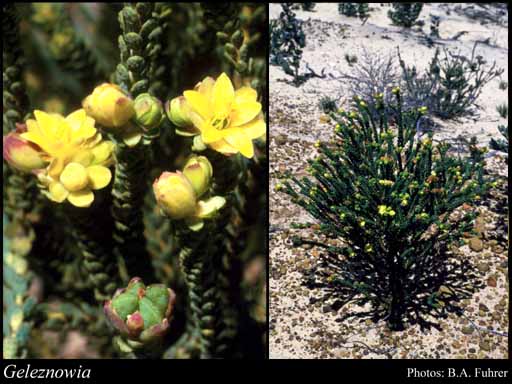- Reference
- Bull.Soc.Imp.Naturalistes Moscou 22(3):12-13 (1849)
- Name Status
- Current

Scientific Description
Family Rutaceae.
Habit and leaf form. Under- shrubs; evergreen, or deciduous; bearing essential oils. Mesophytic, or xerophytic. Leaves small; scattered, crowded; rigid, leathery, or ‘herbaceous’; petiolate; gland-dotted; aromatic; simple. Leaf blades when simple dissected, or entire; when simple/dissected pinnatifid, or much-divided; pinnately veined, or one-veined. Leaves without stipules, or with stipules. Stipules when present, intrapetiolar; represented by glands. Leaf blade margins entire. Leaves without a persistent basal meristem. Stem anatomy. Nodes unilacunar, or tri-lacunar. Secondary thickening developing from a conventional cambial ring.
Reproductive type, pollination. Fertile flowers hermaphrodite. Unisexual flowers absent. Plants hermaphrodite. Entomophilous.
Inflorescence and flower features. Flowers solitary, or aggregated in ‘inflorescences’; in fascicles (clusters, often surrounded by petaloid bracts). The terminal inflorescence unit cymose, or racemose. Inflorescences terminal. Flowers bracteate; small to medium-sized; fragrant; regular, or somewhat irregular. The floral asymmetry when noticeable, involving the perianth and involving the androecium (not K). Flowers 5 merous; cyclic. Floral receptacle developing a gynophore (associated with the disk), or with neither androphore nor gynophore. Free hypanthium absent. Hypogynous disk absent. Perianth with distinct calyx and corolla; 10; 2 -whorled; isomerous. Calyx 5; 1 -whorled; polysepalous; imbricate; exceeding the corolla (and resembling bracts); regular; with the median member posterior. Corolla (3–)4, or 5; 1 -whorled; polypetalous, or gamopetalous; imbricate (similar to sepals but thicker); regular, or unequal but not bilabiate. Androecium 10. Androecial members free of the perianth; all equal, or markedly unequal; free of one another; 1 -whorled, or 2 -whorled. Stamens 10; diplostemonous; alternisepalous, or oppositisepalous (? when the outer whorl lost). Filaments glabrous. Anthers dorsifixed, or basifixed (? more or less); versatile (apex retuse); dehiscing via longitudinal slits; introrse, or latrorse; tetrasporangiate. Gynoecium 5 carpelled; apocarpous; eu-apocarpous; superior. Carpel stylate; apically stigmatic (styles affixed near apex of inner margin of carpels, ovary without a sterile apex); (1–)2–100 ovuled. Placentation of the free carpels marginal. Styles hairless. Stigmas wet type, or dry type; papillate, or non-papillate; Group II type, or Group IV type. Ovules pendulous to ascending; epitropous; when two or more per cell, collateral, or superposed, or biseriate; arillate, or non-arillate; anatropous, or hemianatropous.
Fruit and seed features. Fruit fleshy, or non-fleshy; an aggregate. The fruiting carpels coalescing into a secondary syncarp, or not coalescing. The fruiting carpel dehiscent, or indehiscent; a follicle, or drupaceous, or baccate. Seeds reniform; endospermic, or non-endospermic. Embryo well differentiated. Cotyledons 2. Embryo chlorophyllous, or achlorophyllous; straight, or curved, or bent. Seedling. Germination phanerocotylar, or cryptocotylar.
Physiology, biochemistry. Aluminium accumulation not found. Photosynthetic pathway: C3.
Geography, cytology, number of species. A genus of 1 species.